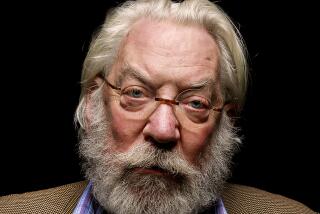World Contingent of Doctors Sit Down Together to Study How Children Walk
- Share via
Twenty-eight medical professionals, some from as far away as the Netherlands, sat huddled in a hospital conference room. They wore business suits and serious expressions. Some scribbled notes furiously; others sat at rapt attention.
What they were studying was not open-heart surgery, or the latest in X-ray equipment, but a television screen showing a solitary child walking . . . just walking .
The doctors are meeting at Children’s Hospital this week to probe every detail of the way kids walk. The conference is the fifth annual “Interpretation of Gait Analysis Data.” Its host is Dr. David Sutherland, who has been at Children’s since 1972.
Has Six Children of His Own
Sutherland, 66, the director of the hospital’s Motion Analysis Laboratory, has spent most of his adult life studying children and, particularly, the way they move their feet.
Sutherland has six children of his own, ranging in age from 32 to 43. His oldest daughter is a pediatrician who has aided him in his work.
Working with children can stimulate every emotion, he said, from euphoria to sadness. Intellectual demands appear more in the form of thinking about the future, anticipating the problems that children with walking abnormalities might face and the correction of them.
Much of the work of the Motion Analysis Laboratory involves looking at kids who exhibit difficulty in walking early. Sutherland and his staff analyze each minute detail of the movement and flow of a child’s gait and make recommendations based on their findings. He works with children “all the way from 18 months to adulthood,” he said.
Herman Woltring, an executive with Philips Medical System, is one of three foreign delegates attending the conference. He said the kind of technology in use at Children’s Hospital represents a “major breakthrough” in analyzing children’s walking. The equipment there makes it easier to recommend for or against surgery, he said.
“A lot of this equipment now available renders an analysis with a dramatically short turnaround time,” said Woltring, who is on sabbatical at the University of Technology in Eindhoven, Holland. “We used to do these manual film analyses that took forever. One stride of a child’s gait (now) takes half a second, but, with the old technology, it might take hours or day to analyze. It’s much quicker now.”
Overanxious Parents Are a Concern
“I’m very much intrigued with the fact that Dr. Sutherland tries to teach gait analysis in a medical context to people of different backgrounds,” Woltring said. “He has medical people, engineering people and physical therapy people all here, and that’s important, because you need all of those people in running a modern gait-analysis lab.”
Sutherland said one of his concerns is overanxious parents who worry that their kids have walking problems when many of them don’t.
“There’s a wide variation in a normal gait,” he said. “It’s important for people to know that, so that children won’t get locked in these useless, senseless efforts to walk better.”
Sutherland said he supports “legitimate applications” of the sports-medicine movement, but characterized its “fringe elements” as feeding the fears of some parents who end up trying to fix something that isn’t broken.
“Some kids have a problem with toe-ing in,” Sutherland said. “And some should be treated in the first year of life with minor casting. But some parents have a natural desire to have their children be as perfect as possible, and that we try to resist.”




